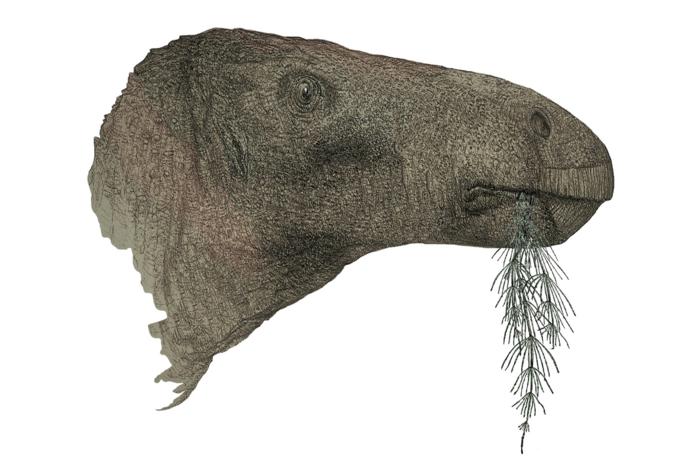Paleontologists have uncovered one of the best-preserved dinosaurs ever found in the United Kingdom on the Isle of Wight. In a recent study, the team presented Comptonatus chasei as a new species of iguanodontian that roamed Earth around 125 million years ago in the Early Cretaceous.
The research team described it as one of the most complete fossil dinosaurs discovered in the U.K. in the last century; the last incredibly well-preserved specimen was also a species of iguanodon. It’s the latest in a number of remarkable dinosaur discoveries from the island.
“A lot of dinosaur fossils really are quite fragmentary,” says Jeremy Lockwood, a scientific associate at the Natural History Museum, who led the examination of the newly described species. “Sometimes a new species is erected on as little as a single jaw, but with Comptonatus chasei, we’ve got nearly every bone in its body.”
The Discovery of Comptonatus chasei
Originally discovered in 2013 by Nick Chase, an avid fossil collector who tragically passed away due to cancer, Lockwood identified the magnificently preserved specimen as a new species and genus, naming it in Chase’s honor and after Compton Bay, where it was discovered.
Another part of its name – “tonatus” – derives from the Latin for ‘thunderous’. Weighing in at around one ton, this herbivorous dinosaur likely roamed the land in large herds. For this reason, iguanodontids are a family of dinosaurs often referred to as the “cattle of the Cretaceous,” says Lockwood. It’s likely this particular specimen was around six years old. That means it was beyond its juvenile years but could have grown even larger.
When Chase first discovered C. chasei, it was thought to be another iguanodontid called Mantellisaurus — which was discovered over 100 years ago. In 2021, Lockwood and his team identified another new iguanodontian species that they named Brighstoneus simmondsi. That particular creature stood out on account of its uniquely bulbous nose and its large number of teeth; while Mantellisaurus has around 24, Brighstoneus has 28. Comptonatus is younger than the bulbous-nosed Brighstoneus but older than Mantellisaurus.
Read More: The Many Iterations of Iguanodon
The Unique Features of Comptonatus chasei
Though similar to these other iguanodontids, Comptonatus also has several key differences that qualify it as a new species and genus, according to the researchers. One of those is an extremely large pubic hip bone that Lockwood compares to a dinner plate. This could mean the species moved differently from other similar iguanodontids, though that’s speculative. Its lower jaw also has a very straight bottom edge, unlike other species that curve downwards.
Remarkable in its own right, this discovery also sheds further light on the flourishing dinosaur diversity at this time in history. The Isle of Wight is now known to have been home to at least four different iguanodontian species – Brighstoneus, Comptonatus, Iguanodon bernissartensis, and Mantellisaurus – potentially separated by only a couple of million years.
Read More: Why Is the Isle of Wight Rich in Dinosaur Fossils?
Dinosaur Diversity in the Cretaceous Period
According to the study, iguanodontians emerged in the late Middle Jurassic period and began to diversify sometime in the Cretaceous. The discovery of C. chasei adds to the evidence that these dinosaurs may have branched off from one another quite rapidly, Lockwood says. It’s not known whether they coexisted at the same time or were pushed together by environmental factors, such as rising sea levels. These are questions that remain to be answered.
The Isle of Wight is home to a remarkable array of dinosaur finds. Lockwood and colleagues have identified other species, such as spinosaurids, large fish-eating theropods, some of which are notorious for the large sails on their backs, and the seven-meter-long Neovenator, that likely preyed on Comptonatus and other iguanodontids.
“We wanted to see if there was more diversity than we thought on the island and there certainly is,” he adds. He is optimistic that other discoveries remain to be made.
“This really is a remarkable find. It helps us understand more about the different types of dinosaurs that lived in England in the Early Cretaceous. This adds to recent research that shows that Wessex was one of the world’s most diverse ecosystems,” says Lockwood.
Read More: A Complete Dinosaur Timeline to Extinction: How Long Did They Roam Earth?
Article Sources
Our writers at Discovermagazine.com use peer-reviewed studies and high-quality sources for our articles, and our editors review for scientific accuracy and editorial standards. Review the sources used below for this article:
Sean Mowbray is a freelance writer based in Scotland. He covers the environment, archaeology, and general science topics. His work has also appeared in outlets such as Mongabay, New Scientist, Hakai Magazine, Ancient History Magazine, and others.




















Discussion about this post